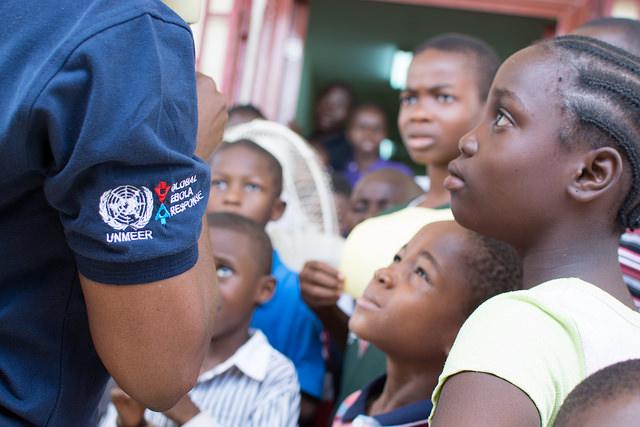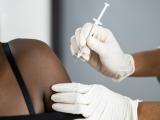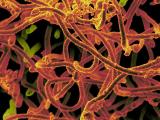Ebola numbers in West Africa's outbreak region tumbled last week, with the lowest totals since May 2014, fueled by improving response indicators in Sierra Leone and Guinea, the World Health Organization (WHO) said today in its weekly epidemiologic snapshot.
In other developments, the WHO said today that its Ebola emergency committee will meet this week to review the latest information about the outbreak, and the group unveiled new standards for foreign health workers who respond to health emergencies, such as the Ebola outbreak.
Liberia didn't report any new confirmed cases last week, so the 30 cases from the region are from Guinea and Sierra Leone, a sizeable drop from the 57 lab-confirmed cases the WHO reported the week before. The latest illnesses include 21 from Guinea and 9 from Sierra Leone. The WHO said the outbreak total has reached 25,515 confirmed, probable, and suspected cases, with the number of deaths rising to 10,572.
No new Ebola infections in healthcare workers were reported, keeping the total at 861, which includes 495 deaths from the disease.
Guinea cases fall, but concerns remain
Guinea's Ebola activity has seen several ups and downs over the outbreak. After a recent increase, however, it dropped sharply last week, from 57 to 21 cases.
The number of districts reporting cases was lower, but the WHO said response indicators show a mixed picture, a reminder of the challenges the country still faces.
The percentage of Ebola deaths occurring in community settings dipped last week, a sign that more sick people are being isolated and treated. However, the WHO said the percentage of confirmed cases occurring among known cases fell only slightly, and 21 unsafe burials were reported—almost the same as the 20 that occurred the previous week.
The WHO said though it appears that Ebola surveillance is improving in Guinea, there are still too many unknown chains of transmission to be confident that the fall in cases will be sustained in the weeks ahead.
Mostly good news in Sierra Leone
In Sierra Leone, the number of confirmed cases dropped for the fifth week in a row to 9, compared with 25 the week before. Its total last week is the country's lowest since the third week of May last year. No unsafe burials were reported during the period, and only 3 of 32 Ebola deaths occurred in community settings.
Those factors and the low proportion of samples that were positive for Ebola boost confidence that Sierra Leone's downward trend will continue, the WHO said. It noted, however, that the percentage of cases that popped up in known contacts fell a bit for the second week in a row, a sign that some challenges remain.
In a related development, a baby's recently reported death from Ebola was mistakenly reported, Reuters reported today, citing a spokesman from Sierra Leone's National Ebola Response Center. The health official attributed the mistake to a "lapse" by health workers who obtained the blood sample.
News of a possible new case in Kailahun district raised concerns, because the area was a former outbreak hot spot that had not registered a case in the past 4 months.
An official from Kailahun district said the false-positive test resulted in indirect deaths at a local clinic, because medical staff were quarantined, which left patients without care.
Liberia situation quiet
Liberia's most recent Ebola case-patient died on Mar 27, and health officials are monitoring 332 contacts. The country tested 310 new lab samples for Ebola, and none were positive.
Montserrado County, located in and around the capital, Monrovia, is the only area of Liberia that has reported a case over the past 6 weeks.
Both Liberia and Sierra Leone have treatment capacity that exceeds demand, and in light of tumbling case counts and shrinking areas of transmission, national authorities, with assistance from the WHO, are starting the process of safely decommissioning facilities. Each country will maintain a core capacity of high-quality Ebola treatment centers, located to ensure geographic coverage, and have the capacity for reserve rapid response.
Emergency committee to meet
In other developments, the WHO's emergency committee on Ebola will meet this week for its fifth time to review recent developments and assess if West Africa's outbreak still warrants a public health emergency of international concern (PHEIC).
Since the group's last meeting in the middle of January, disease activity has dropped off sharply in Liberia, showed steady gradual decreases in Sierra Leone, and has fluctuated in Guinea. A few health workers have been infected while working in the outbreak region and were evacuated to their home countries, and some foreign health workers were potentially exposed and have undergone 21-day active monitoring.
The emergency committee usually meets every 3 months or more often, if needed. The WHO said in an e-mail to journalists that it would announce the committee's recommendation on Apr 10 after the expert meeting concludes. The PHEIC was first declared on Aug 8, which came with recommended steps to help curb the spread of the virus.
Standards for foreign medical teams
Meanwhile, the WHO today unveiled a new system for building a global emergency workforce that can be deployed for public health situations like earthquakes, floods, and disease outbreaks.
It said the Global Foreign Medical Teams Registry sets minimum standards for international health workers and allows teams to spell out their services and skills, steps designed to facilitate a more effective response and improve coordination between aid providers and recipients.
Ian Norton, MD, who leads the WHO's foreign medical team efforts, said in a statement today that the system that was developed helped speed the response to the cyclone that struck Vanuatu, with the first medical team from Australia arriving just 2 days after the storm hit. Since then, 20 teams have helped, with new teams arriving to relieve others.
The WHO said that, in earlier responses, such as Haiti's earthquake and South Asia's tsunami, foreign teams sometimes arrived without coordinating with the national health authorities or international responders. Though well intentioned, some responders lacked the skills, knowledge, or equipment necessary to meet the needs of the local people.
The agency added that the standards were gleaned from lessons learned from earlier responses, including West Africa's Ebola outbreak, which required the coordination of nearly 60 foreign medical teams from 40 organizations.
Also, the WHO is developing best practice guidelines and standards for responders that target specific needs of children, pregnant women, people with disabilities, and seniors.
See also:
Apr 8 WHO situation report
Apr 8 Reuters story
Apr 8 WHO statement on foreign response teams
















